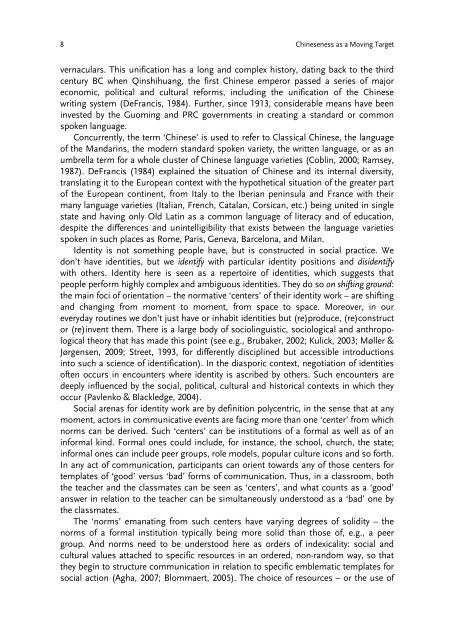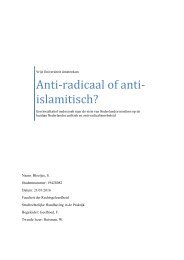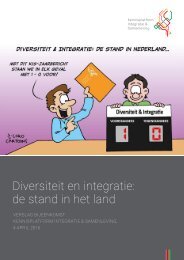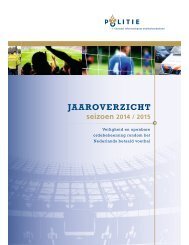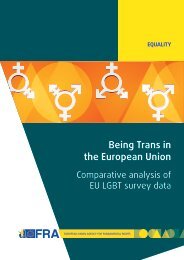Tilburg University Chineseness as a Moving Target Li Jinling
Li_Chineseness_12_09_2016
Li_Chineseness_12_09_2016
You also want an ePaper? Increase the reach of your titles
YUMPU automatically turns print PDFs into web optimized ePapers that Google loves.
8 <strong>Chineseness</strong> <strong>as</strong> a <strong>Moving</strong> <strong>Target</strong><br />
vernaculars. This unification h<strong>as</strong> a long and complex history, dating back to the third<br />
century BC when Qinshihuang, the first Chinese emperor p<strong>as</strong>sed a series of major<br />
economic, political and cultural reforms, including the unification of the Chinese<br />
writing system (DeFrancis, 1984). Further, since 1913, considerable means have been<br />
invested by the Guoming and PRC governments in creating a standard or common<br />
spoken language.<br />
Concurrently, the term ‘Chinese’ is used to refer to Cl<strong>as</strong>sical Chinese, the language<br />
of the Mandarins, the modern standard spoken variety, the written language, or <strong>as</strong> an<br />
umbrella term for a whole cluster of Chinese language varieties (Coblin, 2000; Ramsey,<br />
1987). DeFrancis (1984) explained the situation of Chinese and its internal diversity,<br />
translating it to the European context with the hypothetical situation of the greater part<br />
of the European continent, from Italy to the Iberian peninsula and France with their<br />
many language varieties (Italian, French, Catalan, Corsican, etc.) being united in single<br />
state and having only Old Latin <strong>as</strong> a common language of literacy and of education,<br />
despite the differences and unintelligibility that exists between the language varieties<br />
spoken in such places <strong>as</strong> Rome, Paris, Geneva, Barcelona, and Milan.<br />
Identity is not something people have, but is constructed in social practice. We<br />
don’t have identities, but we identify with particular identity positions and disidentify<br />
with others. Identity here is seen <strong>as</strong> a repertoire of identities, which suggests that<br />
people perform highly complex and ambiguous identities. They do so on shifting ground:<br />
the main foci of orientation – the normative ‘centers’ of their identity work – are shifting<br />
and changing from moment to moment, from space to space. Moreover, in our<br />
everyday routines we don’t just have or inhabit identities but (re)produce, (re)construct<br />
or (re)invent them. There is a large body of sociolinguistic, sociological and anthropological<br />
theory that h<strong>as</strong> made this point (see e.g., Brubaker, 2002; Kulick, 2003; Møller &<br />
Jørgensen, 2009; Street, 1993, for differently disciplined but accessible introductions<br />
into such a science of identification). In the di<strong>as</strong>poric context, negotiation of identities<br />
often occurs in encounters where identity is <strong>as</strong>cribed by others. Such encounters are<br />
deeply influenced by the social, political, cultural and historical contexts in which they<br />
occur (Pavlenko & Blackledge, 2004).<br />
Social aren<strong>as</strong> for identity work are by definition polycentric, in the sense that at any<br />
moment, actors in communicative events are facing more than one ‘center’ from which<br />
norms can be derived. Such ‘centers’ can be institutions of a formal <strong>as</strong> well <strong>as</strong> of an<br />
informal kind. Formal ones could include, for instance, the school, church, the state;<br />
informal ones can include peer groups, role models, popular culture icons and so forth.<br />
In any act of communication, participants can orient towards any of those centers for<br />
templates of ‘good’ versus ‘bad’ forms of communication. Thus, in a cl<strong>as</strong>sroom, both<br />
the teacher and the cl<strong>as</strong>smates can be seen <strong>as</strong> ‘centers’, and what counts <strong>as</strong> a ‘good’<br />
answer in relation to the teacher can be simultaneously understood <strong>as</strong> a ‘bad’ one by<br />
the cl<strong>as</strong>smates.<br />
The ‘norms’ emanating from such centers have varying degrees of solidity – the<br />
norms of a formal institution typically being more solid than those of, e.g., a peer<br />
group. And norms need to be understood here <strong>as</strong> orders of indexicality: social and<br />
cultural values attached to specific resources in an ordered, non-random way, so that<br />
they begin to structure communication in relation to specific emblematic templates for<br />
social action (Agha, 2007; Blommaert, 2005). The choice of resources – or the use of


